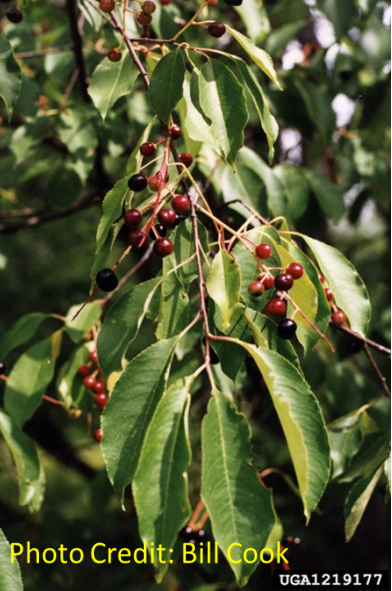While there are over 600 species of weeds that can be labeled as poisonous plants, we are going to focus on my top ten that can be found in our pastures in Georgia. Most grazing animals will not eat poisonous plants unless they are forced to do so by some unusual or artificial condition. Conditions leading to ingestion include lack of good forage (due to drought or overgrazing), deficient rations, and newly cultivated areas. These plants can be especially problematic for our livestock that prefer to browse, or just the ones that are inquisitive. When ingested, poisonous plants can have a wide range of effects – causing chemical or physiological disturbances.

- Black Cherry (Prunus serotine) is a medium size tree often seen growing on fencerows. All livestock can be affected; however, ruminants are more susceptible. Livestock may begin showing signs of poisoning within 15 to 30 minutes after consumption. One of the most common signs of poisoning is bright red mucous membranes and blood.
- Chinaberry (Melia azedarach) is a small to medium sized tree with a light purple and white flower. Once a popular ornamental tree, this invasive plant can now be found along fence rows, roadsides, waste areas, and around buildings. Swine and sheep are most susceptible, but all livestock can be affected when consumed in large amounts. Signs include stomach irritation, vomiting, bloody diarrhea, paralysis, irregular breathing, and trouble breathing.
- Horsenettle (Solanum carolinense) is a perennial weed of the nightshade family. This is a thorny weed that contains a green/yellow fruit that resembles a tomato. It is common throughout the South in pastures and hayfields. All grazing animals can be affected. Signs include weakness, excess salivation, shortness of breath, trembling, progressive paralysis, acute hemorrhagic gastroenteritis, collapse, and death.
- Johnsongrass (Sorghum halepense) is a coarse perennial grass that can grow up to 8 feet tall. This grass is found throughout the South in fields, waste areas, and along fence rows. Johnsongrass is generally a high -quality forage that is safe to graze. The problem lies after a significant stress event – extreme drought or frost. Prussic acid accumulates in the plant after drought or frost and can be toxic. All livestock can be affected, but ruminants are most susceptible. Signs include difficulty breathing, anxious or staggering, collapse, and convulsions before death. Bright red color of mucous membranes and blood are another sign of consumption. Often if the animal show signs 15-30 minutes after consumption, they may die within the hour.
- Perilla Mint (Perilla frutescens) is a low growing annual that produces a strong odor when crushed. This weed can be found in pastures, fields, along the roadside, and old home sites. Horses and cattle are the most susceptible, but all livestock can be affected. Hay containing perilla mint, can cause birth defects in calves during early gestation. Signs occur 2-10 days after exposure and include labored breathing, lowering head, reluctance to move, and death on exertion. Pulmonary emphysema and edema are also signs.
- Pokeweed (Phytolacca Americana) is a perennial herb that can grow up to 9 feet. It is well known for the dark purple to black berries it produces. It is most commonly found on waste areas, fence rows, pastures, and old home sites. Pokeweed affects most livestock. Signs include vomiting, abdominal pain, bloody diarrhea, breakdown of red blood cells, drop in milk production, convulsions, and death from respiratory failure. Most animals recover within 24-48 hours after removal from source. Post mortem often reveals ulcerative gastritis, mucosal hemorrhage, and dark liver.
- Rhododendrons and Azaleas (Rhododendron spp.) are naturally found in the Appalachian Mountains, but are a common ornamental shrub in many Southern landscapes. Ruminants are most susceptible, but horses and other monogastric animals can be affected but are less likely to consume. Signs include bloating, salivation, vomiting, and abdominal pain. Eventually the animal will grow weak, stagger and become prostrate.
- Dallisgrass Ergot (Claviceps paspali on Paspalum dilatatum) is a fungal mass that grows on the seedhead of dallisgrass. It begins as a tan/orange, round mass and becomes black and shrunken. Dallisgrass Ergot affects all grazing animals. Signs can occur 3 days after consumption. Affected livestock can exhibit “stagger,” or lack of coordination when walking, or not be able to get back up after laying down. Death is usually rare.
- Ground Cherry (Physalis spp.) can be an annual or perennial herb. The fruit/berry on the plant is surrounded by a papery sac. While technically the fruit can be consumed when fully ripe, it is toxic when still green. This weed can be found on the edge of fields and disturbed areas. All grazing animals are susceptible. Signs include weakness, excess salivation, shortness of breath, trembling, progressive paralysis, acute hemorrhagic gastroenteritis, collapses and death.
- Sneezeweed (Helenium spp.) is an annual or perennial herb with yellow flowers. This weed is found throughout the South with Autumn sneezeweed being more common in the Piedmont and Bitter sneezeweed more common in the Coastal Plains. All livestock can be affected, but sheep are the most susceptible. Signs include sever irritation to the mucous membranes, dullness, trembling, restlessness, stiff gait, salivation, and weakness. Also called “spewing sickness,” severe vomiting and possible inhaling of regurgitated material may cause pneumonia.
On a more positive note, if pastures and hay fields are well managed, many weeds can be suppressed or eliminated. Be sure to scout your fields, pastures, and fence lines for noxious weeds. Soil sample your pastures and hay fields to know your fertilizer and lime recommendations before application. Ensure your pastures are not being overgrazed or under grazed. Consider “rational” or rotational grazing in pastures. For hay fields, make sure you are cutting at the recommend height for your forage species. There are also many herbicides that can be implemented into your program to help control these weeds. Contact your local county extension agent or forage team member for more information.